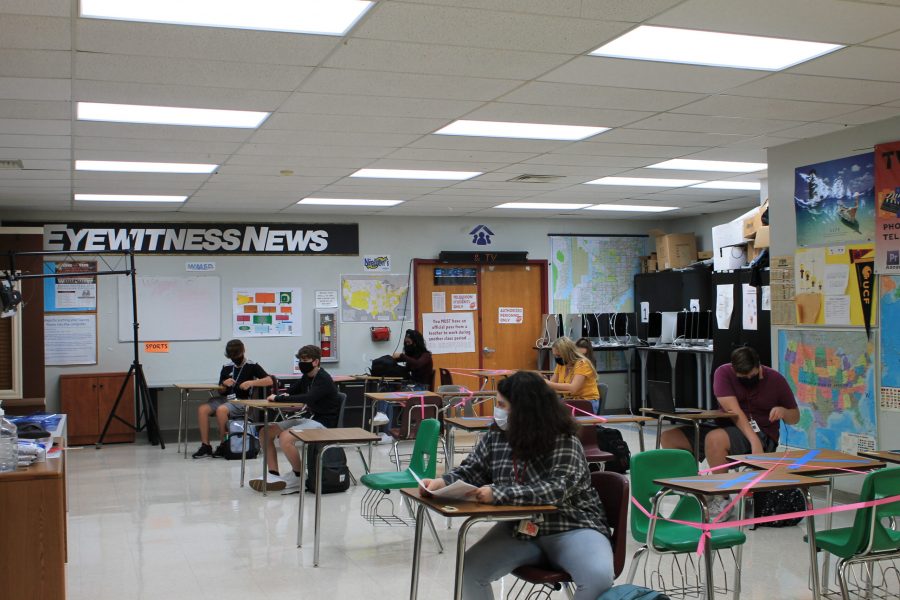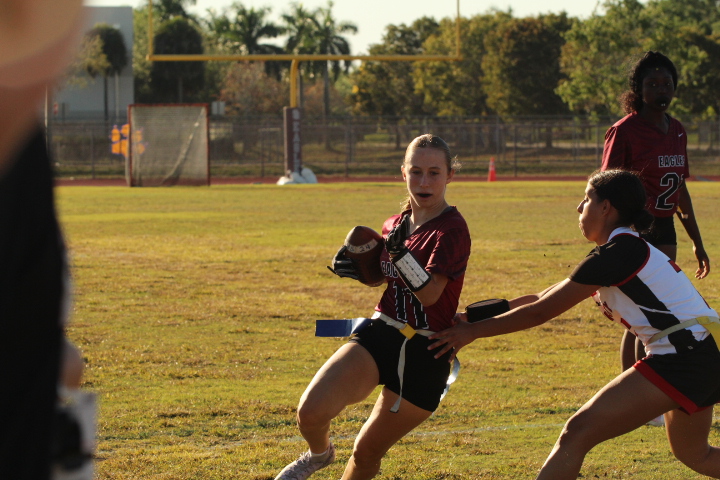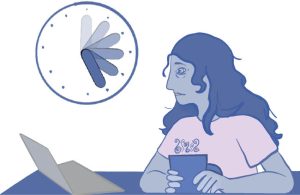Teachers create alternative testing formats to quiz students in online school
November 12, 2020
Since the start of the 2020-2021 school year, both teachers and students at Marjory Stoneman Douglas High School have had to endure much trial and error before getting into a relatively normal rhythm. Virtual learning has been a completely new experience for everyone, and has caused teachers to experiment with alternative ways to teach. These experimental ways of teaching have produced different ways for students to take assessments in their classes.
Precalculus teacher Michael Powell has decided to take a more interactive approach with his tests. He believes that some precalculus problems don’t fit on a completely written exam. To ensure he creates a full, in-depth test, Powell uses multiple tactics.
“I typically do a written assessment that counts for 20% of the grade and an oral assessment that counts for 80%,” Powell said.
For the written assessment, students must answer questions at home and show their work on a sheet of paper, similar to a traditional test style. Students then have to scan and submit their work to Powell’s inbox to get credit.
However, on the oral exam, Powell separates his students into two groups, usually alphabetically, who have specific time slots for taking their tests. Once in class, students use whiteboards and answer each question Powell displays on his shared screen. Students must wait until time is up to present their answers to Powell, who will then check for the correct response and give points accordingly.
Although the oral tests make up a large portion of a student’s grade in the class, it does not mean that students should not try on the written tests. Mr. Powell uses the written test as a way to test students’ skills= in questions that may be more complicated. It gives students more time to complete the questions, so he can do it more in-depth.
Powell gives his students tests in this specific way because it helps prevent them from cheating.
“I do a lot of private tutoring, and most students readily admit they cheat regularly during distance learning,” Powell said. “My kids know I love them, but I’d be foolish to think they’re not tempted to take shortcuts to maintain their GPA.”
During virtual school, it has become very easy for students to search up answers to questions on another browser or look at their notes without their teacher being able to tell. By making tests with a strict time limit and enforcing the camera on rule, there is a decreased opportunity for students to cheat as easily.
One of Powell’s reasons for not assigning Canvas tests is due to the large margin of error in Canvas’s format. On Canvas, teachers are usually limited to making questions a fill-in-the-blank or multiple choice.
Powell does not believe in using multiple choice, and finds it bothersome how the questions can cause so many errors. Due to the basic nature of Canvas’s tests, he must go back and grade each test answer individually to prevent students from getting questions wrong if they put the right answer, which proves to be very time consuming.
Before the COVID-19 pandemic, Powell only gave his tests in a written format.
“If I’m still teaching by the time we return to normal, I’ll be going back to traditional written tests,” Powell said. “I only made these changes because of distance learning.”
Other teachers have taken an entirely different route. Freshman english teacher Ashley Dawson decided to give her tests through a different website entirely. Her friend and coworker Kristen Coniff, another Language Arts teacher at MSD, referred her to Quizizz, a website that allows teachers to create live timed quizzes, for tests.
Quizizz gives Dawson many benefits that she wouldn’t have gotten through Canvas. The platform is very interactive and engages students in a fun way.
“[Quizizz] allows the students to compete against each other and raises their competitive spirits,” Dawson said. “I can see class averages and how well everyone performed on each question. It also shows me who has not started the quiz and the pace everyone is on.”
Tests through Quizizz, although unconventional, provide a fun and new way for students to take tests. It has many similarities to another well-known platform called Kahoot, which is based on competing against other individuals to get the best score possible. In these competitive scenarios, students are more likely to do better to surpass their peers.
Dawson decided to think outside of the box. as her number one goal was for her students to enjoy learning. She feels that it is vital for students to be engaged in the work they are doing and finds that traditional tests are not useful for what she is trying to achieve. Quizizz may not be a choice you would think of at first, but it definitely provides a new way to engage students.
Dawson has similar beliefs to Powell in the sense that testing isn’t enough to properly assess students’ understanding.
“I will be switching back and forth between Canvas and Quizizz,” Dawson said. “I may occasionally give these tests as quick comprehension checks for my classes.”
Just like Powell, Dawson plans on switching back to her normal ways once school gains back its normality.
During virtual learning, Algebra II teacher James Gard decided to simplify the standard way of testing out of convenience. He gave his tests on Canvas in the format of multiple choice questions. He decided to do so as opposed to fill-in-the-blank tests because it makes it easier to grade.
“To grade a test that is not multiple choice takes many hours per class,” Gard said. “Canvas is, at best, terrible for making math tests, as it takes a good two hours to make a basic, 15 questions or so test [since] formatting them is a major chore.”
The oddity in this form of testing comes from the fact that Gard is a math teacher. Many math teachers provide fill-in-the-blank tests to prevent students from taking random guesses on tests. However, it is truly up to the teacher if they want to prioritize convenience or thoroughness.
Before the start of the COVID-19 pandemic when students were still conducting face-to-face learning, Gard used a different method of testing, as did most teachers. Instead of multiple choice, he would have his students write out their work and go through all the steps for every problem.
This method is the traditional way of testing for most American teachers. It allows teachers to tell the difference between guesses and actual knowledge, and makes it hard for students to cheat successfully.
Gard is not confident in online tests, and believes that there are not many ways to prevent students from cheating on them.
“As tests are online, there is basically no way to tell if the work was legitimately done,” Gard said.
However, even though his tests are currently online, he still requires his students to turn in the work on a piece of paper along with the answers. This proves to him that the student took the test legitimately, and does not take very long to grade either.
Throughout this confusing time, teachers have had to adapt their ways of teaching. Whether they change it slightly or completely rearrange their approach to teaching, everyone has had to make changes. Powell, Dawson and Gard were only a few teachers who have changed their test formats, but there is no shortage of educators doing this at MSD.














